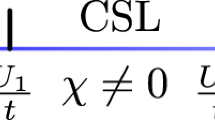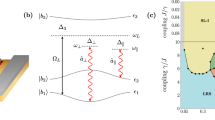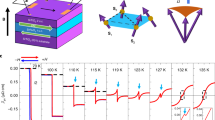Abstract
Spin liquids are magnetically frustrated systems, in which spins are prevented from ordering or freezing, owing to quantum or thermal fluctuations among degenerate states induced by the frustration. Chiral spin liquids are a hypothetical class of spin liquids in which the time-reversal symmetry is macroscopically broken in the absence of an applied magnetic field or any magnetic dipole long-range order. Even though such chiral spin-liquid states were proposed more than two decades ago1,2,3, an experimental realization and observation of such states has remained a challenge. One of the characteristic order parameters in such systems is a macroscopic average of the scalar spin chirality, a solid angle subtended by three nearby spins. In previous experimental reports, however, the spin chirality was only parasitic to the non-coplanar spin structure associated with a magnetic dipole long-range order or induced by the applied magnetic field4,5,6,7,8,9,10, and thus the chiral spin-liquid state has never been found. Here, we report empirical evidence that the time-reversal symmetry can be broken spontaneously on a macroscopic scale in the absence of magnetic dipole long-range order. In particular, we employ the anomalous Hall effect4,11 to directly probe the broken time-reversal symmetry for the metallic frustrated magnet Pr2Ir2O7. An onset of the Hall effect is observed at zero field in the absence of uniform magnetization, within the experimental accuracy, suggesting an emergence of a chiral spin liquid. The origin of this spontaneous Hall effect is ascribed to chiral spin textures4,5,12,13, which are inferred from the magnetic measurements indicating the spin ice-rule formation14,15.
This is a preview of subscription content, access via your institution
Access options
Subscribe to this journal
Receive 51 print issues and online access
$199.00 per year
only $3.90 per issue
Buy this article
- Purchase on Springer Link
- Instant access to full article PDF
Prices may be subject to local taxes which are calculated during checkout



Similar content being viewed by others
References
Baskaran, G. & Anderson, P. W. Gauge theory of high-temperature superconductors and strongly correlated Fermi systems. Phys. Rev. B 37, 580–583 (1988)
Laughlin, R. B. The relationship between high-temperature superconductivity and the fractional quantum Hall effect. Science 242, 525–533 (1988)
Wen, X. G., Wilczek, F. & Zee, A. Chiral spin states and superconductivity. Phys. Rev. B 39, 11413–11423 (1989)
Nagaosa, N., Sinova, J., Onoda, S., MacDonald, A. & Ong, N. P. Anomalous Hall effect. http://arxiv.org/abs/0904.4154 (2009)
Taguchi, Y., Oohara, Y., Yoshizawa, H., Nagaosa, N. & Tokura, Y. Spin chirality, Berry phase, and anomalous Hall effect in a frustrated ferromagnet. Science 291, 2573–2576 (2001)
Taniguchi, T. et al. Direct observation of chiral susceptibility in the canonical spin glass AuFe. Phys. Rev. Lett. 93, 246605 (2004)
Pureur, P., Fabris, F. W., Schaf, J. & Campbell, I. A. Chiral susceptibility in canonical spin glass and reentrant alloys from Hall effect measurements. Europhys. Lett. 67, 123–129 (2004)
Grohol, D. et al. Spin chirality on a two-dimensional frustrated lattice. Nature Mater. 4, 323–328 (2005)
Neubauer, A. et al. Topological Hall effect in the A phase of MnSi. Phys. Rev. Lett. 102, 186602 (2009)
Lee, M., Kang, W., Onose, Y., Tokura, Y. & Ong, N. P. Unusual Hall effect anomaly in MnSi under pressure. Phys. Rev. Lett. 102, 186601 (2009)
Hall, E. H. On the ‘rotational coefficient’ in nickel and cobalt. Proc. Phys. Soc. Lond. 4, 325–342 (1880)
Ye, J. et al. Berry phase theory of the anomalous Hall effect: application to colossal magnetoresistance manganites. Phys. Rev. Lett. 83, 3737–3740 (1999)
Kawamura, H. Anomalous Hall effect as a probe of the chiral order in spin glasses. Phys. Rev. Lett. 90, 047202 (2003)
Bramwell, S. T. & Gingras, M. J. P. Spin ice state in frustrated magnetic pyrochlore materials. Science 294, 1495–1501 (2001)
Moessner, R. & Ramirez, A. Geometrical frustration. Phys. Today 59, 24–29 (2006)
Thouless, D. J., Kohmoto, M., Nightingale, M. P. & den Nijs, M. Quantized Hall conductance in a two-dimensional periodic potential. Phys. Rev. Lett. 49, 405–408 (1982)
Sundaram, G. & Niu, Q. Wave-packet dynamics in slowly perturbed crystals: gradient corrections and Berry-phase effects. Phys. Rev. B 59, 14915–14925 (1999)
Berry, M. V. Quantum phase factors accompanying adiabatic changes. Proc. R. Soc. Lond. A 392, 45–57 (1984)
Landau, L. D. & Lifshitz, E. M. Electrodynamics of Continuous Media 2nd edn (Elsevier, 1984)
Metalidis, G. & Bruno, P. Topological Hall effect studied in simple models. Phys. Rev. B 74, 045327 (2006)
Onoda, S. & Tanaka, Y. Quantum melting of spin ice into spin smectic with cooperative quadrupole and chirality. http://arxiv.org/abs/0907.2536 (2009)
Nakatsuji, S. et al. Metallic spin-liquid behavior of the geometrically frustrated Kondo lattice Pr2Ir2O7 . Phys. Rev. Lett. 96, 087204 (2006)
Machida, Y. et al. Unconventional anomalous Hall effect enhanced by a noncoplanar spin texture in the frustrated Kondo lattice Pr2Ir2O7 . Phys. Rev. Lett. 98, 057203 (2007)
MacLaughlin, D. E. et al. Weak quasistatic magnetism in the frustrated Kondo lattice Pr2Ir2O7 . Physica B 404, 667–670 (2009)
Sakakibara, T., Tayama, T., Hiroi, Z., Matsuhira, K. & Takagi, S. Observation of a liquid-gas type transition in the pyrochlore spin ice compound Dy2Ti2O7 in a magnetic field. Phys. Rev. Lett. 90, 207205 (2003)
Wada, K. & Takayama, H. Nonlinear susceptibilities of the Sherrington-Kirkpatrick model and the spherical model. Prog. Theor. Phys. 64, 327–329 (1980)
Gardner, J. S. et al. Cooperative paramagnetism in the geometrically frustrated pyrochlore antiferromagnet Tb2Ti2O7 . Phys. Rev. Lett. 82, 1012–1015 (1999)
Molavian, H. R., Gingras, M. J. & Canals, B. Dynamically induced frustration as a route to a quantum spin ice state in Tb2Ti2O7 via virtual crystal field excitations and quantum many body effects. Phys. Rev. Lett. 98, 157204 (2007)
Ikeda, A. & Kawamura, H. Ordering of the pyrochlore Ising model with the long-range RKKY interaction. J. Phys. Soc. Jpn 77, 073707 (2008)
Siddharthan, R., Shastry, B. S. & Ramirez, A. P. Spin ordering and partial ordering in holmium titanate and related systems. Phys. Rev. B 63, 184412 (2001)
Acknowledgements
We thank L. Balicas, H. Kawamura, Y. Maeno, Y. Matsumoto, N. Nagaosa, Y. Ohta and T. Taniguchi for their support and discussions. This work is partially supported by Grants-in-Aid from the Japanese Society for the Promotion of Science, by Grants-in-Aid for Scientific Research on Priority Areas and Scientific Research on Innovative Areas from the Ministry of Education, Culture, Sports, Science and Technology, Japan, and by the Kurata Grant. Y.M. is supported by JSPS research fellowships. The calculations were performed in part by using the RIKEN Super Combined Cluster (RSCC).
Author Contributions S.N. planned the experimental project, and Y.M. and S.N. collected data and wrote the paper; S.O. gave the theoretical interpretation, performed the calculations, and wrote the paper; T.T. and T.S. collected data. All authors discussed the results and commented on the manuscript.
Author information
Authors and Affiliations
Corresponding author
Ethics declarations
Competing interests
The authors declare no competing financial interests.
Supplementary information
Supplementary Information
This file contains Supplementary Methods, Supplementary Data, Supplementary Notes, Supplementary Figures S1-S3 with Legends and Supplementary References. (PDF 955 kb)
Rights and permissions
About this article
Cite this article
Machida, Y., Nakatsuji, S., Onoda, S. et al. Time-reversal symmetry breaking and spontaneous Hall effect without magnetic dipole order. Nature 463, 210–213 (2010). https://doi.org/10.1038/nature08680
Received:
Accepted:
Published:
Issue Date:
DOI: https://doi.org/10.1038/nature08680
This article is cited by
-
Spin–orbital liquid state and liquid–gas metamagnetic transition on a pyrochlore lattice
Nature Physics (2023)
-
A microscopic Kondo lattice model for the heavy fermion antiferromagnet CeIn3
Nature Communications (2023)
-
Emergence of Weyl fermions by ferrimagnetism in a noncentrosymmetric magnetic Weyl semimetal
Nature Communications (2023)
-
Strain-tunable Berry curvature in quasi-two-dimensional chromium telluride
Nature Communications (2023)
-
An anomalous Hall effect in altermagnetic ruthenium dioxide
Nature Electronics (2022)
Comments
By submitting a comment you agree to abide by our Terms and Community Guidelines. If you find something abusive or that does not comply with our terms or guidelines please flag it as inappropriate.



